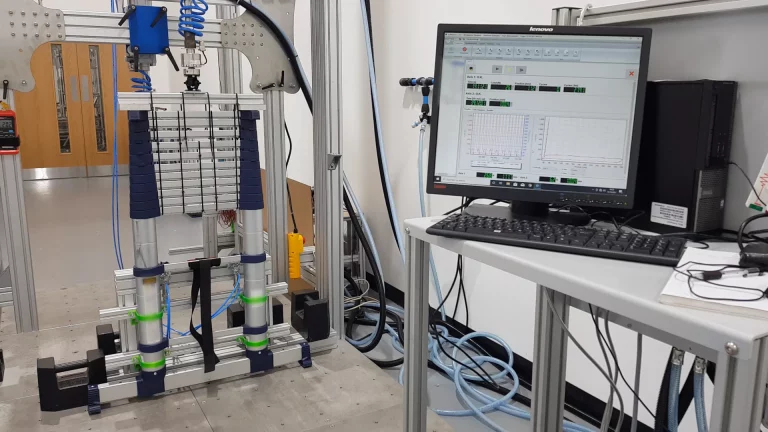“To the multi-disciplinary test houses, [telescopic ladders] are just one product in hundreds they provide testing for. What we really wanted was a test lab we could talk to, in the UK, and who really understood the product and the standard.” – Francis Camilleri, Business Development Director, T.B. Davies
10th August 2022
With a heritage spanning four generations, T.B. Davies has a reputation for durable products, where safety details are integral to their design.
The company is focused on “reducing work injuries to zero” and want to make working at height as safe as standing on solid ground.
T.B. Davies first came across the US-based Xtend+Climb at a trade show in Germany around 2003. Having been introduced to its telescopic ladder, the team were encouraged to learn that it was sold on its performance rather than price. It was clear that telescopic ladders could occupy their own space in the work at height market, but with so many moving parts, a properly engineered solution was key to user safety.
At the time, telescopic ladders were a new invention, with several companies bringing them to market. As the name suggests, a telescopic ladder can be extended or retracted into itself. This design makes them compact for easy storage and shipping. An added benefit is height adjustment, making them ideal in small spaces.
Impressed by the Xtend+Climb product, the company ethos and early sales in the US, T.B. Davies took a gamble on ordering. Full containers of ladders were not cheap, especially when paying up front, but they had faith in the product as a safe, engineered solution.
In those days, there was not a specific product standard for telescopic ladders. So, instead it was validated to the relevant parts of EN 131 Parts 1 and 2, which had been around since 1993. Backed by manufacturer and third-party testing, combined with several US and international patents, T.B. Davies felt they had found a good quality product for their expanding portfolio.
Fast forward nearly 20 years, and the Xtend+Climb telescopic ladders are an essential part of the T.B. Davies product range. Product standards have developed a lot over that time, and the products have developed with them. The EN 131 family of standards now has a part specifically for telescopic ladders: EN 131-6:2019. Over the years, Xtend+Climb have continued to develop their products to meet customer and standards requirements, as Francis explains;
“Xtend+Climb has never succumbed to price pressures. They have stuck to making a good quality and well-engineered solution to keep people safe when working at height. The materials have to be right. The tolerances have to be right. Otherwise, the product gets loose and unreliable.”
“Users don’t always think about the consequences when buying work at height equipment – and the consequences of a fall from height. We provide equipment that needs to keep people safe when working at height – cost should not be the only driver.”

Business Development Director
Over nearly 20 years, the team at T.B. Davies had built a strong relationship with Xtend+Climb, as Francis explains;
“Xtend+Climb telescopic ladders have always had a low defect rate with us. They have proved to be solid and reliable products. This was backed up by their in-house QA and third-party testing in the Far East, Europe and the US.
But quality and reliability come at a price, and the UK market in recent years has been somewhat flooded with cheaper, lower quality products, which all claim conformity to EN 131-6. At the moment, the playing field is far from level. We face a constant challenge with buyers, distributors, and retailers to understand this.”
Francis also had concerns about how the market was changing. In recent years, more and more ladders are being sold online. This means users can no longer “feel” the quality between different telescopic ladders.
Alongside that, it is easier than ever for people to buy ladders online directly from the manufacturer overseas, by the container load, and either distribute them themselves or act as an agent and sell onto others.
“It is becoming more challenging – supply chains are getting longer and a product like a telescopic ladder can have been through 5, 6 or 7 entities before it reaches the end user. And everyone in that chain is relying purely on trust that the one before has undertaken their due diligence. Where companies expand into selling ladders, where they have limited knowledge, that is where we see issues – and where fighting on price is the primary driver.”
T.B. Davies and Xtend+Climb had a strong relationship and over the years had built up evidence of low defect rates. However, they had struggled to find a way to demonstrate the quality difference to their UK customers.
“We had always wanted to have the products tested in the UK – a way of independently validating what we had been told from Xtend+Climb and the test labs they had used. Should there ever be a problem, we wanted our own evidence that the product conforms to EN 131-6.
But every time we tried to talk to UK and EU test houses, we either didn’t get an answer or it dragged on for months. To the multi-disciplinary test houses, this is just one product in hundreds they provide testing for.
What we really wanted was a test lab we could talk to, in the UK, and who really understood the product and the standard.”
T.B. Davies approached Test & Research Centre for help. Over a few months, samples were supplied and we tested them against the requirements of EN 131-6:2019. This is the specific part of the EN 131 standards family which contains requirements for telescopic ladders. It includes requirements for:
Telescopic ladders have many moving parts, which means there’s more opportunity for something to go wrong. This means testing is vital to ensure they won’t fail in use. The testing involved in EN 131-6 is rigorous and really puts the ladder under some serious stress, with some of the test loads in excess of 270kg. In addition, there are checks of the dimensions and design – such as consistent rung pitches and mechanisms to prevent injury when closing.
After several weeks of testing the samples that were provided successfully passed the assessed requirements of EN 131-6.


The team at T.B. Davies were pleased with the outcome of the testing.



Business Development Director
““It was great news to have a specialist in the Test & Research Centre confirm that the Xtend+Climb telescopic ladder was compliant to EN 131-6.
Having a UK-based test laboratory assess these products was important to us. Local confirmation that the product complies means we can have more meaningful conversations with our customers. We can now show all stakeholders that the product conforms; whether that’s a customer, regulator, or distributor.
It gives us more collateral to shift the conversation away from price alone.”
Ultimately, having the telescopic ladders tested by the Test & Research Centre has given T.B. Davies the independent reassurance they needed. Nearly 20 years of experience with distributing Xtend+Climb telescopic ladders shows the pedigree of the product. Being able to confirm this locally, with a specialist test laboratory, now gives T.B. Davies new insight to share with customers.
“These days too many companies are run ‘by spreadsheet’ – driven only by bottom line performance. We undertook this testing to give us more evidence that the product meets or exceeds the requirements of EN 131-6. We will continue to move the conversation away from price and focus more on user safety.
And we are not stopping there. This was an important exercise, but it’s a point in time. Products, production methods and standards all evolve. Now we have a baseline, we are working with the Test & Research Centre to develop an ongoing surveillance programme. This will give us ongoing confidence in the product, from an independent third party.
We would strongly recommend that anyone involved in selling telescopic ladders have them independently tested. If they believe they conform to EN 131-6, go and prove it. We stand by the products we sell and care about keeping users safe when they leave the ground.”
The Test & Research Centre was founded to help make access products and their users safer.
If you’re a manufacturer, supplier or importer of non-powered access products and you’re looking to have a product tested or Certified, contact us for a friendly chat about how Test & Research Centre can help.
Contact us using the form below and we will call you back to find out how we can help.
34 Regal Drive, Soham, Cambridgeshire, CB7 5BE.
A UK-based Certification Body, Test Laboratory and training facility that specialises in access equipment.